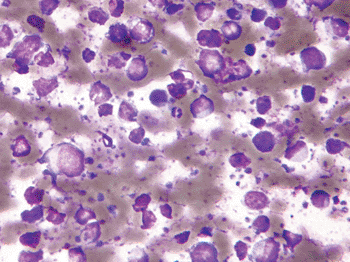Test Identifies Risk of Developing Lymphoma
By LabMedica International staff writers
Posted on 17 Feb 2014
The immune system is responsible for eliminating potentially cancerous immune B-cells in their early stages, before they developed into B-cell lymphomas, also known as non-Hodgkin's lymphomas.Posted on 17 Feb 2014
Immune cells undergo spontaneous changes on a daily basis that could lead to cancers if not for the diligent surveillance of the immune system and this immune surveillance accounts for the surprising rarity of B-cell lymphomas in the population, given how often these spontaneous changes occur.

Image: Micrograph of large B-cell lymphoma from a fine needle aspirate of a lymph node (Photo courtesy of Nephron).
Scientists at Walter and Eliza Hall Institute (Melbourne, Australia) discovered that the loss of function of the tumor suppressor gene PR Domain Containing 1, with ZNF Domain (PRDM1), also known as B-Lymphocyte-Induced Maturation Protein (BLIMP1) or deregulated expression of the oncogene B-Cell CLL/Lymphoma 6 (BCL6), occurs in a large proportion of diffuse large B-cell lymphoma (DLBCL) cases.
Targeted mutation of either gene in a rodent model leads to only slow and infrequent development of malignant lymphoma and despite frequent mutation of BCL6 in activated B- cells of healthy individuals, lymphoma development is rare. The scientists found that T-cells prevent the development of overt lymphoma, and impairment of T-cell control results in rapid development of DLBCL-like disease, which can be eradicated by polyclonal cluster of differentiation 8 (CD8+) T-cells in a T-cell receptor, CD28-dependent and Fas ligand-dependent manner.
David Tarlinton, PhD, a coauthor of the study, said, “In the majority of patients, the first sign that something is wrong is finding an established tumor, which in many cases is difficult to treat. Now that we know B-cell lymphoma is suppressed by the immune system, we could use this information to develop a diagnostic test that identifies people in early stages of this disease, before tumors develop and they progress to cancer. There are already therapies that could remove these 'aberrant' B-cells in at-risk patients, so once a test is developed it can be rapidly moved towards clinical use.” The study was published on February 2, 2014, in the journal Nature Medicine.
Related Links:
Walter and Eliza Hall Institute







 assay.jpg)






